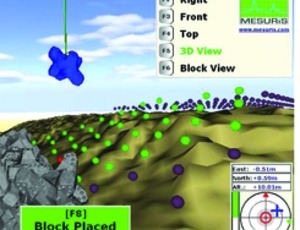
Monsoon season in the Arabian Peninsula's Sultanate of Oman goes from early June to mid-September, bringing with it predictably rough weather that can stir up the seas. For workers building a 3-kilometer-long breakwater at a $3.25-billion greenfield port at Dugm, this could hamper their work a bit.
The stormy forecast led Muhammad D. Suleiman El Dawood, the site project manager, to adopt a GPS- and sensor-aided system for underwater placement of the 7.5- and 22-ton Core-Loc precast-concrete armor units for the breakwater. The system is helping El Dawood's team work through foul weather and double their production rates to meet a May 2012 completion for phase one.
“At first, we started fixing the Core-Locs as we always had, with a GPS unit on the end of the crane and divers helping to guide the blocks. We had difficulties because we couldn't control the orientation and couldn't see the blocks through the murky water,” says El Dawood.
The Core-Loc armor unit, patented by the U.S. Army Corp of Engineers, must be placed within a 10-centimeter accuracy and at an exact orientation to properly lock and withstand wave forces, El Dawood says. Precision is a must because they are designed to be laid down in a single layer. By contrast, El Dawood says, most other armor units require two layers to achieve the same protection levels.
The contractor says that is why he turned to a three-year-old control system called POSIBLOC, from the French firm Mesuris S.A. It combines GPS positioning technology and quick-release attitude sensors on the load into a 3D guidance system to direct each of the armor units to its target position and proper orientation in the design. The system is calibrated to a 3D terrain model and does not rely on video.
El Dawood also took advantage of a recently released visual add-on to the system, VISIBLOC Processing software, which adds operational analysis and optimizes POSIBLOC by monitoring and recording each unit's trajectory during placement. It detects out-of-profile units and calculates the packing density achieved. In effect, it builds a 3D model of the project that can be navigated by the crane operator and foreman as the assembly proceeds.
VISIBLOCK then transmits a full image of the underwater environment and each unit's location in real time, viewable from multiple angles, to the crane operator's and foreman's display. It shows the seabed, highlights the placement targets and shows the orientation of each unit being placed, as well as the units that already have been set down.
El Dawood says he is able to follow the block from land to seabed, and the minute he disengages the attitude sensor, he gets an as-built image. “This saves me money by finishing earlier, saving on divers and saving on as-built,” he says.
El Dawood notes that when he was considering using the POSIBLOC system—which can cost $200,000 or more—he learned of two other projects that tried it without success. He says he wanted to tour their sites and observe the system, but the operators were unable to get it to work.
So El Dawood hired a fulltime IT engineer and a geomatics engineer. He was able to double production and finished his part of the project ahead of schedule. “Some certain days I achieved more than 100 Core-Locs per day,” he says. “It's much safer than the old system that required divers throughout.”


Post a comment to this article
Report Abusive Comment